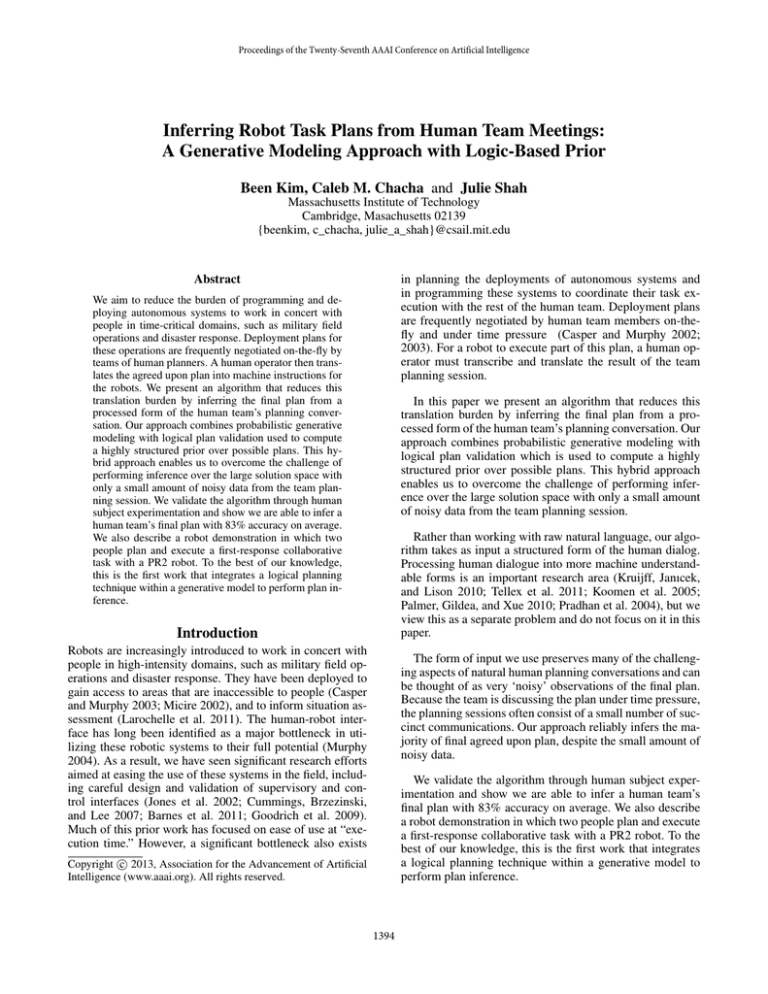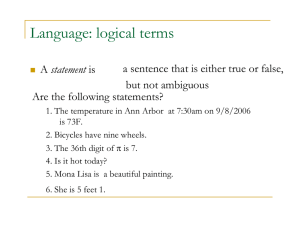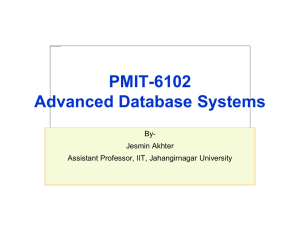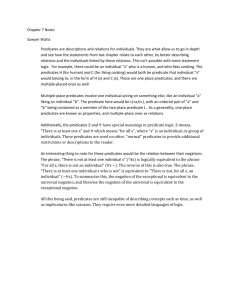
Proceedings of the Twenty-Seventh AAAI Conference on Artificial Intelligence
Inferring Robot Task Plans from Human Team Meetings:
A Generative Modeling Approach with Logic-Based Prior
Been Kim, Caleb M. Chacha and Julie Shah
Massachusetts Institute of Technology
Cambridge, Masachusetts 02139
{beenkim, c_chacha, julie_a_shah}@csail.mit.edu
Abstract
in planning the deployments of autonomous systems and
in programming these systems to coordinate their task execution with the rest of the human team. Deployment plans
are frequently negotiated by human team members on-thefly and under time pressure (Casper and Murphy 2002;
2003). For a robot to execute part of this plan, a human operator must transcribe and translate the result of the team
planning session.
We aim to reduce the burden of programming and deploying autonomous systems to work in concert with
people in time-critical domains, such as military field
operations and disaster response. Deployment plans for
these operations are frequently negotiated on-the-fly by
teams of human planners. A human operator then translates the agreed upon plan into machine instructions for
the robots. We present an algorithm that reduces this
translation burden by inferring the final plan from a
processed form of the human team’s planning conversation. Our approach combines probabilistic generative
modeling with logical plan validation used to compute
a highly structured prior over possible plans. This hybrid approach enables us to overcome the challenge of
performing inference over the large solution space with
only a small amount of noisy data from the team planning session. We validate the algorithm through human
subject experimentation and show we are able to infer a
human team’s final plan with 83% accuracy on average.
We also describe a robot demonstration in which two
people plan and execute a first-response collaborative
task with a PR2 robot. To the best of our knowledge,
this is the first work that integrates a logical planning
technique within a generative model to perform plan inference.
In this paper we present an algorithm that reduces this
translation burden by inferring the final plan from a processed form of the human team’s planning conversation. Our
approach combines probabilistic generative modeling with
logical plan validation which is used to compute a highly
structured prior over possible plans. This hybrid approach
enables us to overcome the challenge of performing inference over the large solution space with only a small amount
of noisy data from the team planning session.
Rather than working with raw natural language, our algorithm takes as input a structured form of the human dialog.
Processing human dialogue into more machine understandable forms is an important research area (Kruijff, Janıcek,
and Lison 2010; Tellex et al. 2011; Koomen et al. 2005;
Palmer, Gildea, and Xue 2010; Pradhan et al. 2004), but we
view this as a separate problem and do not focus on it in this
paper.
Introduction
Robots are increasingly introduced to work in concert with
people in high-intensity domains, such as military field operations and disaster response. They have been deployed to
gain access to areas that are inaccessible to people (Casper
and Murphy 2003; Micire 2002), and to inform situation assessment (Larochelle et al. 2011). The human-robot interface has long been identified as a major bottleneck in utilizing these robotic systems to their full potential (Murphy
2004). As a result, we have seen significant research efforts
aimed at easing the use of these systems in the field, including careful design and validation of supervisory and control interfaces (Jones et al. 2002; Cummings, Brzezinski,
and Lee 2007; Barnes et al. 2011; Goodrich et al. 2009).
Much of this prior work has focused on ease of use at “execution time.” However, a significant bottleneck also exists
The form of input we use preserves many of the challenging aspects of natural human planning conversations and can
be thought of as very ‘noisy’ observations of the final plan.
Because the team is discussing the plan under time pressure,
the planning sessions often consist of a small number of succinct communications. Our approach reliably infers the majority of final agreed upon plan, despite the small amount of
noisy data.
We validate the algorithm through human subject experimentation and show we are able to infer a human team’s
final plan with 83% accuracy on average. We also describe
a robot demonstration in which two people plan and execute
a first-response collaborative task with a PR2 robot. To the
best of our knowledge, this is the first work that integrates
a logical planning technique within a generative model to
perform plan inference.
c 2013, Association for the Advancement of Artificial
Copyright Intelligence (www.aaai.org). All rights reserved.
1394
Problem Formulation
Disaster response teams are increasingly utilizing webbased planning tools to plan their deployments (Di Ciaccio,
Pullen, and Breimyer 2011). Dozens to hundreds of responders log in to plan their deployment using audio/video conferencing, text chat, and annotatable maps. In this work, we
focus on inferring the final plan using the text data that can
be logged from chat or transcribed speech. This section formally describes our problem formulation, including the inputs and outputs of our inference algorithm.
Planning Problem
A plan consists of a set of actions together with execution
timestamps associated with those actions. A plan is valid if
it achieves a user-specified goal state without violating userspecified plan constraints. In our work, the full set of possible actions is not necessarily specified apriori and actions
may also be derived from the dialog.
Actions may be constrained to execute in sequence or
in parallel with other actions. Other plan constraints include discrete resource constraints (e.g. there are two medical teams), and temporal deadlines on time durative actions
(e.g. a robot can be deployed for up to one hour at a time due
to battery life constraints). Formally, we assume our planning problem may be represented in Planning Domain Description Language (PDDL) 2.1.
In this paper, we consider a fictional rescue scenario that
involves a radioactive material leakage accident in a building with multiple rooms, as shown in Figure 1. This is the
scenario we use in human subject experiments for proof-ofconcept of our approach. A room either has a patient that
needs to be assessed in person or a valve that needs to be
fixed. The scenario is specified by the following information.
Goal State: All patients are assessed in person by a medical crew. All valves are fixed by a mechanic. All rooms are
inspected by a robot.
Constraints: For safety, the radioactivity of a room must be
inspected by a robot before human crews can be sent to the
room (sequence constraint). There are two medical crews,
red and blue (discrete resource constraint). There is one human mechanic (discrete resource constraint). There are two
robots, red and blue (discrete resource constraint).
Assumption: All tasks (e.g. inspecting a room, fixing a
valve) take the same unit of time and there are no hard
temporal constraints in the plan. This assumption was made
to conduct the initial proof-of-concept experimentation described in this paper. However, the technical approach readily generalizes to variable task durations and temporal constraints, as described later.
The scenario produces a very large number of possible
plans (more than 1012 ), many of which are valid for achieving the goals without violating the constraints.
We assume that the team reaches an agreement on a final plan. Techniques introduced by (Kim, Bush, and Shah
2013) can be used to detect the strength of agreement, and
encourage the team to discuss further to reach an agreement
if necessary. We leave for future study the situation where
Figure 1: Fictional rescue scenario
the team agrees on a flexible plan with multiple options to
be decided among later. While we assume that the team is
more likely to agree on a valid plan, we do not rule out the
possibility that the final plan is invalid.
Algorithm Input
Text data from the human team conversation is collected in
the form of utterances, where each utterance is one person’s
turn in the discussion, as shown in Table 1. The input to
our algorithm is a machine understandable form of human
conversation data, as illustrated in the right-hand column of
Table 1. This structured form captures the actions discussed
and the proposed ordering relations among actions for each
utterance.
Although we are not working with raw natural language,
this form of data still captures many of the characteristics
that make plan inference based on human conversation challenging. Table 1 shows part of the data, using the following
short-hand:
ST = SendTo
rr = red robot, br = blue robot
rm = red medical, bm = blue medical
e.g. ST(br, A) = SendTo(blue robot, room A)
Utterance tagging An utterance is tagged as an ordered
tuple of sets of grounded predicates. Each predicate represents an action applied to a set of objects (crew member,
robot, room, etc.), as is the standard definition of a dynamic
predicate in PDDL. Each set of grounded predicates represents a collection of actions that, according to the utterance,
should happen in parallel. The order of the sets of grounded
predicates indicates the relative order in which these collections of actions should happen. For example, ({ST(rr,
B), ST(br, G)}, {ST(rm, B)}) corresponds to simultaneously
sending the red robot to room B and the blue robot to room
G, followed by sending the red medical team to room B.
As one can see, the structured dialog is still very noisy.
Each utterance (i.e. U1-U7) discusses a partial plan and only
predicates that are explicitly mentioned in the utterance are
tagged (e.g. U6-U7: the “and then” in U7 implies a sequencing constraint with the predicate discussed in U6, but the
1395
Natural dialogue
So I suggest using Red robot
U1 to cover “upper” rooms (A, B,
C, D) and Blue robot to cover
“lower” rooms (E, F, G, H).
U2 Okay. so first send Red robot
to B and Blue robot to G?
U3 Our order of inspection would
be (B, C, D, A) for Red and
then (G, F, E, H) for Blue.
U4 Oops I meant (B, D, C, A) for
Red.
···
U5 So we can have medical crew
go to B when robot is inspecting C
···
U6 First, Red robot inspects B
U7 Yes, and then Red robot inspects D, Red medical crew to
treat B
Technical Approach and Related Work
Structured form
({ST(rr,A),ST(br,E),
ST(rr,B),ST(br,F),
ST(rr,C),ST(br,G),
ST(rr,D), ST(br,H)})
({ST(rr,B),ST(br,G)})
It is natural to take a probabilistic approach to the plan inference problem since we are working with noisy data. However the combination of a small amount of noisy data and a
very large number of possible plans means that an approach
using typical uninformative priors over plans will frequently
fail to converge to the team’s plan in a timely manner.
This problem could also be approached as a logical constraint problem of partial order planning, if there were no
noise in the utterances. In other words, if the team discussed
only the partial plans relating to the final plan and did not
make any errors or revisions, then a plan generator such as a
PDDL solver (Coles et al. 2009) could produce the final plan
with global sequencing. Unfortunately human conversation
data is sufficiently noisy to preclude this approach.
This motivates a combined approach. We build a probabilistic generative model for the structured utterance observations. We use a logic-based plan validator (Howey, Long,
and Fox 2004) to compute a highly structured prior distribution over possible plans, which encodes our assumption that
the final plan is likely, but not required, to be a valid plan.
This combined approach naturally deals with noise in the
data and the challenge of performing inference over plans
with only a small amount of data. We perform sampling inference in the model using Gibbs sampling and MetropolisHastings steps within to approximate the posterior distribution over final plans. We show through empirical validation
with human subject experiments that the algorithm achieves
83% accuracy on average.
Combining a logical approach with probabilistic modeling has gained interest in recent years. (Getoor and Mihalkova 2011) introduce a language for describing statistical models over typed relational domains and demonstrate
model learning using noisy and uncertain real-world data.
(Poon and Domingos 2006) introduce statistical sampling
to improve the efficiency of search for satisfiability testing.
(Richardson and Domingos 2006; Singla and Domingos ;
Poon and Domingos 2009; Raedt 2008) introduce Markov
logic networks, and form the joint distribution of a probabilistic graphical model by weighting the formulas in a firstorder logic.
Our approach shares with Markov logic networks the philosophy of combining logical tools with probabilistic modeling. Markov logic networks utilize a general first-order logic
to help infer relationships among objects, but they do not
explicitly address the planning problem, and we note the
formulation and solution of planning problems in first-order
logic is often inefficient. Our approach instead exploits the
highly structured planning domain by integrating a widely
used logical plan validator within the probabilistic generative model.
({ST(rr,B),ST(br,G)},
{ST(rr,C),ST(br,F)},
{ST(rr,D),ST(br,E)},
{ST(rr,A), ST(br,H)})
({ST(rr,B)},{ST(rr,D)},
{ST(rr,C)},{ST(rr,A)})
({ST(m,B), ST(r,C)})
({ST(r,B)})
({ST(r,D),ST(rm,B)})
Table 1: Dialogue and structured form examples
structured form of U7 does not include ST(r,B)). Typos and
misinformation are tagged as they are (e.g. U3), and the
utterances to revise information are not placed in context
(e.g. U4). Utterances that clearly violate ordering constraints
(e.g. U1: all actions cannot happen at the same time) are
tagged as they are. In addition, the information regarding
whether the utterance was a suggestion, rejection or agreement of an partial plan is not coded.
Note that the utterance tagging only contains information
about relative ordering between the predicates appearing in
that utterance, not the absolute ordering of their appearance
in the final plan. For example, U2 specifies that the two
grounded predicates happen at the same time. It does not say
when the two predicates happen in the final plan or whether
other predicates happen in parallel. This simulates how humans perceive the conversation — at each utterance, humans
only observe the relative ordering, and infer the absolute order of predicates based on the whole conversation and an
understanding of which orderings make a valid plan.
Algorithm Output
The output of the algorithm is an inferred final plan, which
is sampled from the probability distribution over final plans.
The final plan has a similar representation to the structured
utterance tags, and is represented as an ordered tuple of sets
of grounded predicates. The predicates in each set represent
actions that happen in parallel, and the ordering of sets indicates sequence. Unlike the utterance tags, the sequence ordering relations in the final plan represent the absolute order
in which the actions are to be carried out. For example, a
plan can be represented as ({A1 , A2 }, {A3 }, {A4 , A5 , A6 }),
where Ai represents a predicate. In this plan, A1 and A2 will
happen at plan time step 1, A3 happens at plan time step 2,
and so on.
Algorithm
Generative Model
In this section, we explain the generative model of human
team planning dialog (Figure 2) that we use to infer the
team’s final plan. We start with a plan latent variable that
must be inferred by observing utterances in the planning
1396
α
session. The model generates each utterance in the conversation by sampling a subset of the predicates in plan and
computing the relative ordering in which they appear in the
utterance. This mapping from the absolute ordering in plan
to the relative ordering of predicates in an utterance is described in more detail below. Since the conversation is short,
and the noise level is high, our model does not distinguish
utterances based on the order of which they appear in the
conversation.
We describe the generative model step by step:
plan
snt
β
s0t
T
Figure 2: The generative model
where α is a positive number. This models our assumption that the final plan is more likely, but not necessarily
required, to be a valid plan. We describe in the next section how we evaluate the validity of a plan.
Each set of predicates in plan is assigned a consecutive
absolute plan step index s, starting at s = 1 working
from left to right in the ordered tuple. For example, given
plan = ({A1 , A2 }, {A3 }, {A4 , A5 , A6 }), where each Ai
is a predicate, A1 and A2 occur in parallel at plan step
s = 1 and A6 occurs at plan step s = 3.
2. Variable snt : Each of n predicates in an utterance t is
assigned a step index snt . snt is given by the absolute plan
step s where the corresponding predicate pnt (explained
later), appears in plan.
snt is sampled as follows. For each utterance, n predicates are sampled from plan. For example, consider
n = 2 where first sampled predicate appears in the second set of plan and the second sampled predicate appears
in the fourth set of plan. Then s1t = 2 and s2t = 4.
The probability of a set being sampled is proportional to
the number of predicates in the set. For example, given
plan = ({A1 , A2 }, {A3 }, {A4 , A5 , A6 }), the probability
of selecting the first set ({A1 , A2 }) is 26 . This models that
people are more likely to discuss plan steps that include
many predicates. Formally,
# predicates in set i in plan
.
total # predicates in plan
pnt
N
1. Variable plan: The plan variable in Figure 2 is defined
as an ordered tuple of sets of grounded predicates and represents the final plan agreed upon by the team. The prior
distribution over the plan variable is given by:
α
e
if plan is valid
(1)
p(plan) ∝
1
if plan is invalid.
p(snt = i|plan) =
wp
produces a vector of consecutive indeces. For example, f
maps st = (2, 4) to s0t = (1, 2), and st = (5, 7, 2) to
s0t = (2, 3, 1).
This variable models the way predicates and their orders
appear in human conversation; people do not often refer
to the absolute ordering, and frequently use relative terms
such as “before” and “after” to describe partial sequences
of the full plan. People also make mistakes or otherwise
incorrectly specify an ordering, hence our model allows
for inconsistent relative orderings with nonzero probability.
4. Variable pnt : The variable pnt represents the nth predicate
that appears in the tth utterance. This is sampled given snt ,
the plan variable and a noise parameter wp .
With probability wp , we sample the predicate pnt uniformly from the “correct” set snt in plan as follows:
(
1
if i is in set j
p(pnt = i|plan, snt = j) = # pred. in set j
0
o.w.
With probability 1 − wp , we sample the predicate pnt uniformly from “any” set in plan (i.e. from all predicates
mentioned in the dialog), therefore
1
p(pnt = i|plan, snt = j) =
. (4)
total # predicates
In other words, with higher probability wp , we sample a
value for pnt that is consistent with snt , but allow nonzero
probability that pnt is sampled from a random plan. This
allows the model to incorporate the noise in the planning
conversation, including mistakes or plans that are later revised.
(2)
3. Variable s0t : The variable s0t is an array of size n that
specifies, for each utterance t, the relative ordering of
predicates as they appear in plan.
s0t is generated from st as follows:
β
e
if s0t = f (st )
0
p(st |st ) ∝
(3)
1
if s0t 6= f (st ).
PDDL Validator
We use the Planning Domain Description Language (PDDL)
2.1 plan validator tool (Howey, Long, and Fox 2004) to evaluate the prior distribution over possible plans. The plan validator is a standard tool that takes as input a planning problem described in PDDL and a proposed solution plan, and
where β > 0. The function f is a deterministic mapping
from the absolute ordering st to the relative ordering s0t .
f takes as input a vector of absolute plan step indices and
1397
represented as an ordered tuple of sets of predicates, and the
new point is suggested by performing one of the following
moves:
checks if the plan is valid. Some validators can also compute
a value for plan quality, if the problem specification includes
a plan metric. Validation is often much cheaper than generating a valid plan, and gives us a way to compute p(plan) up to
proportionality in a computationally efficient manner. Leveraging this efficiency, we use Metropolis-Hastings sampling
to sample the plan without calculating the partition function,
as described in the next section.
Many elements of the PDDL domain and problem specification are defined by the capabilities and resources at a
particular response team’s disposal. The PDDL specification
may largely be reused from mission to mission, but some elements will change or may be specified incorrectly. For example the plan specification may misrepresent the number
of responders available or may leave out implicit constraints
that people take for granted. In the Experimental Evaluation
section we demonstrate the robustness of our approach using
both complete and degraded PDDL plan specifications.
• Select a predicate. If it is in the current plan, move it to
either: 1) the next set of predicates, 2) the previous set
or 3) remove it from the current plan. If it is not in the
current plan, move it to one of the existing set.
• Select two sets in plan, and switch their orders.
These moves are sufficient to move from an arbitrary plan to
another arbitrary plan using the set of moves defined above.
The probability of each of these moves described above is
chosen such that the the proposal distribution is symmetric:
Q(x0 |xt ) = Q(xt |x0 ). This symmetry simplifies the calculation of the acceptance ratio.
Second, the ratios of the proposal distribution at the current and proposed points are calculated. When plan is valid
and invalid respectively, p(plan) is proportional to eα and 1
respectively, as described in Equation 1. Plan validity is evaluated using the PDDL validation tool. The remaining term,
p(snt |plan)p(pnt |plan, snt ), is calculated using Equations 2
and 4.
Third, the proposed
plan is accepted
with the following
∗
(plan=x0 |s,p)
probability: min 1, pp∗ (plan=x
,
where
p∗ is a function
t |s,p)
that is proportional to the posterior distribution.
Gibbs Sampling
We use Gibbs sampling to perform inference on the generative model. There are two latent variables to sample: plan
and the collection of variables snt . We iterate between sampling plan given all other variables and sampling the snt variables given all other variables. The PDDL validator is used
when the plan variable is sampled.
Unlike snt , where we can write down an analytic form to
sample from the posterior, it is intractable to directly resample the plan variable, as it requires calculating the number
of all possible valid and invalid plans. Therefore we use
a Metropolis-Hasting (MH) algorithm to sample from the
plan posterior distribution within the Gibbs sampling steps.
In this section, we explain how plan and the snt variables are
sampled.
Sampling snt Fortunately, there exists an analytic expression for the posterior of snt :
p(st |plan, pt , s0t ) ∝ p(st |plan)p(pt , s0t |plan, st )
= p(st |plan)p(pt |plan, st )p(s0t |st )
= p(s0t |st )
Note this analytic expression can be expensive to evaluate
if the number of possible values of snt is large. In that case
one can marginalize out snt , as the one variable we truly care
about is the plan variable.
p(plan|s, p) ∝ p(plan)p(s, p|plan)
= p(plan)
p(snt , pnt |plan)
Experimental Evaluation
t=1 n=1
= p(plan)
T Y
N
Y
p(snt |plan)p(pnt |plan, snt )
n=1
Sampling plan using Metropolis-Hastings The posterior
of plan can be represented as the product of the prior and
likelihood as follows:
N
T Y
Y
N
Y
In this section we evaluate the performance of our plan inference algorithm through initial proof-of-concept human subject experimentation and show we are able to infer a human
team’s final plan with 83% accuracy on average. We also describe a robot demonstration in which two people plan and
execute a first-response collaborative task with a PR2 robot.
Human Team Planning Data We designed a web-based
collaboration tool that is modeled after the NICS system (Di Ciaccio, Pullen, and Breimyer 2011) used by first response teams, but with a modification that requires the team
to communicate soley via text chat. Twenty-three teams of
two (total of 46 participants) were recruited through Amazon Mechanical Turk and the greater Boston area. Recruitment was restricted to participants located in US to increase
the probability that participants were fluent in English. Each
team was provided the fictional rescue scenario described
in this paper, and was asked to collaboratively plan a rescue
p(snt |plan)p(pnt |plan, snt )
t=1 n=1
(5)
The MH sampling algorithm is widely used to sample from a distribution when direct sampling is difficult.
The typical MH algorithm defines a proposal distribution,
Q(x0 |xt ) which samples a new point (i.e. x0 : a value of
the plan variable in our case) given the current point
xt . The new point can be achieved by randomly selecting one of the possible moves, as defined below. The proposed point is accepted or rejected with probability of
min(1, acceptance ratio).
Unlike simple cases where a Gaussian distribution can
be used as a proposal distribution, our proposal distribution
needs to be defined over the plan space. Recall that plan is
1398
mission. At the completion of the planning session, each participant was asked to summarize the final agreed upon plan
in the structured form described previously. An independent
analyst reviewed the planning sessions to resolve discrepancies between the two member’s final plan descriptions, when
necessary. Utterance tagging was performed by the three analysts: the first and second authors, and an independent analyst. Two of the three analysts tagged and reviewed each
team planning session. On average, 19% of predicates mentioned per data set did not end up in the final plan.
Algorithm Implementation The algorithm is implemented
in Python, and the VAL PDDL 2.1 plan validator (Howey,
Long, and Fox 2004) is used. We perform 3000 Gibbs sampling steps on the data from each planning session. Within
one Gibbs sampling step, we perform 400 steps of the
Metropolis-Hastings (MH) algorithm to sample the plan.
Every 20 samples are selected to measure the accuracy. wp
is set to 0.8, α is 10, β is 5.
Results We evaluate the quality of the final plan produced
by our algorithm in terms of (1) accuracy of task allocation
among agents (e.g. which medic travels to which room), and
(2) accuracy of plan sequence.
Two metrics for task allocation accuracy are evaluated:
1) [% Inferred] the percent of inferred plan predicates that
appear in the team’s final plan, and 2) [% Noise Rej] the
percent noise rejection of extraneous predicates that are discussed but do not appear in the team’s final plan.
We evaluate the accuracy of the plan sequence as follows. We say a pair of predicates is correctly ordered if it
is consistent with the relative ordering in the true final plan.
We measure the percent accuracy of sequencing [% Seq] by
# correctly ordered pairs of correct predicates
. Only correctly estimated
total # of pairs of correct predicates
predicates are compared, as there is no ground truth relation for predicates that are not in the true final plan. We use
this relative sequencing measure because it does not compound the sequence errors, as an absolute difference measure would (e.g. where the error in the ordering of one predicate early in the plan shifts the position of all subsequent
predicates).
Overall plan accuracy is computed as the arithmetic mean
of the two task allocation and one plan sequence accuracy
measures. Our algorithm is evaluated under three conditions:
1) [PDDL] perfect PDDL files, 2) [PDDL-1] PDDL problem
file with missing goals/constants (delete one patient and one
robot), 3) [PDDL-2] PDDL domain file missing a constraint
(delete precondition that a robot needs to inspect the room
before a human crew can enter), and 4) [no PDDL] using an
uninformative prior over possible plans.
Results, shown in Table 2, show that our algorithm infers
final plans with greater than 80% on average, and achieves
good noise rejection of extraneous predicates discussed in
conversation. We also show our approach is relatively robust
to degraded PDDL specifications.
Concept-of-Operations Robot Demonstration We illustrate the use of our plan inference algorithm with a robot
demonstration in which two people plan and execute a firstresponse collaborative task with a PR2 robot. Two participants plan an impending deployment using the web-based
PDDL
PDDL-1
PDDL-2
No PDDL
Task Allocation
% Inferred % Noise Rej
92.2
71
91.4
67.9
90.8
68.5
88.8
68.2
% Seq
Avg.
85.8
84.1
84.2
73.4
83.0
81.1
81.1
76.8
Table 2: Plan Accuracy Results
collaborative tool that we developed. Once the planning session is complete, the dialog is manually tagged. The plan
inferred from this data is confirmed with the human planners, and is provided to the robot to execute. The registration of predicates to robot actions, and room names to map
locations, is performed offline in advance. While the first
responders are on their way to the accident scene, the PR2
autonomously navigates to each room performing online localization, path planning, and obstacle avoidance. The robot
informs the rest of the team as it inspects each room and confirms it is safe for the human team members to enter. Video
of this demo is here: http://tiny.cc/uxhcrw.
Future Work
Our aim is to reduce the burden of programming a robot to
work in concert with a human team. We present an algorithm
that combines a probabilistic approach with logical plan validation to infer a plan from human team conversation. We
empirically demonstrate that this hybrid approach enables
us to infer the team’s final plan with about 83% accuracy on
average.
Next, we plan to investigate the speed and ease with which
a human planner can “fix” the inferred plan to achieve near
100% plan accuracy. We are also investigating automatic
mechanisms for translating raw natural dialog into the structured form our algorithm takes as input.
Acknowledgement
The authors thank Matt Johnson and James Saunderson for
helpful discussions and feedback.
This work is sponsored by ASD (R&E) under Air
Force Contract FA8721-05-C-0002. Opinions, interpretations, conclusions and recommendations are those of the authors and are not necessarily endorsed by the United States
Government.
References
Barnes, M.; Chen, J.; Jentsch, F.; and Redden, E. 2011.
Designing effective soldier-robot teams in complex environments: training, interfaces, and individual differences. In
EPCE. Springer. 484–493.
Casper, J., and Murphy, R. 2002. Workflow study on humanrobot interaction in usar. In IEEE ICRA, volume 2, 1997–
2003.
Casper, J., and Murphy, R. 2003. Human-robot interactions
during the robot-assisted urban search and rescue response
at the world trade center. IEEE SMCS 33(3):367–385.
1399
Pradhan, S.; Ward, W.; Hacioglu, K.; Martin, J.; and Jurafsky, D. 2004. Shallow semantic parsing using support vector
machines. In NAACL-HLT, 233.
Raedt, L. 2008. Probabilistic logic learning. Logical and
Relational Learning 223–288.
Richardson, M., and Domingos, P. 2006. Markov logic networks. Machine learning 62(1):107–136.
Singla, P., and Domingos, P. Markov logic in infinite domains. In UAI.
Tellex, S.; Kollar, T.; Dickerson, S.; Walter, M.; Banerjee,
A.; Teller, S.; and Roy, N. 2011. Understanding natural
language commands for robotic navigation and mobile manipulation. In AAAI.
Coles, A.; Fox, M.; Halsey, K.; Long, D.; and Smith, A.
2009. Managing concurrency in temporal planning using planner-scheduler interaction. Artificial Intelligence
173(1):1 – 44.
Cummings, M. L.; Brzezinski, A. S.; and Lee, J. D.
2007. Operator performance and intelligent aiding in unmanned aerial vehicle scheduling. IEEE Intelligent Systems
22(2):52–59.
Di Ciaccio, R.; Pullen, J.; and Breimyer, P. 2011. Enabling distributed command and control with standardsbased geospatial collaboration. In IEEE International Conference on HST.
Getoor, L., and Mihalkova, L. 2011. Learning statistical
models from relational data. In International Conference on
Management of data, 1195–1198. ACM.
Goodrich, M. A.; Morse, B. S.; Engh, C.; Cooper, J. L.;
and Adams, J. A. 2009. Towards using UAVs in wilderness search and rescue: Lessons from field trials. Interaction Studies, Special Issue on Robots in the Wild: Exploring Human-Robot Interaction in Naturalistic Environments
10(3):453–478.
Howey, R.; Long, D.; and Fox, M. 2004. Val: Automatic
plan validation, continuous effects and mixed initiative planning using pddl. In IEEE ICTAI, 294–301. IEEE.
Jones, H.; Rock, S.; Burns, D.; and Morris, S. 2002. Autonomous robots in swat applications: Research, design, and
operations challenges. AUVSI.
Kim, B.; Bush, L.; and Shah, J. 2013. Quantitative estimation of the strength of agreements in goal-oriented meetings.
In IEEE CogSIMA.
Koomen, P.; Punyakanok, V.; Roth, D.; and Yih, W. 2005.
Generalized inference with multiple semantic role labeling
systems. In CoNLL, 181–184.
Kruijff, G.; Janıcek, M.; and Lison, P. 2010. Continual
processing of situated dialogue in human-robot collaborative activities. In IEEE Ro-Man.
Larochelle, B.; Kruijff, G.; Smets, N.; Mioch, T.; and Groenewegen, P. 2011. Establishing human situation awareness
using a multi-modal operator control unit in an urban search
& rescue human-robot team. In IEEE Ro-Man, 229–234.
IEEE.
Micire, M. 2002. Analysis of robotic platforms used at the
world trade center disaster. Ph.D. Dissertation, MS thesis, Department Computer Science Engineering, Univ. South
Florida.
Murphy, R. 2004. Human-robot interaction in rescue
robotics. IEEE SMCS 34(2):138–153.
Palmer, M.; Gildea, D.; and Xue, N. 2010. Semantic role
labeling. Synthesis Lectures on Human Language Technologies 3(1):1–103.
Poon, H., and Domingos, P. 2006. Sound and efficient inference with probabilistic and deterministic dependencies. In
AAAI, volume 21, 458.
Poon, H., and Domingos, P. 2009. Unsupervised semantic
parsing. In EMNLP.
1400







